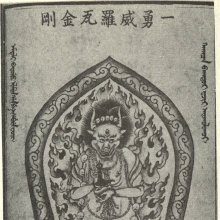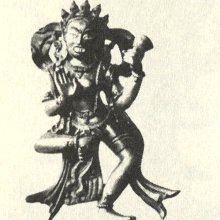Ekavira, Eka-vira, Ekavīrā, Ekavīra: 17 definitions
Introduction:
Ekavira means something in Buddhism, Pali, Hinduism, Sanskrit, biology. If you want to know the exact meaning, history, etymology or English translation of this term then check out the descriptions on this page. Add your comment or reference to a book if you want to contribute to this summary article.
Images (photo gallery)
In Hinduism
Shaktism (Shakta philosophy)
Source: Wisdom Library: ŚāktismEkavīrā (एकवीरा, “Formost Heroine”):—One of the names of Mahākālī (tamas-form of Mahādevī). Mahākālī is one of the three primary forms of Devī. Not to be confused with Kālī, she is a more powerful cosmic aspect (vyaṣṭi) of Devi and represents the guṇa (universal energy) named tamas. For reference, see the Devī Māhātmya, a Sanskrit work from the 5th century, incorporated into the Mārkaṇḍeya-Purāṇa.
Source: Google Books: ManthanabhairavatantramEkavīrā (एकवीरा) is a form of Tripurabhairavī who is worshopped as the Yakṣiṇī Raudrī, according to the Manthānabhairavatantra, a vast sprawling work that belongs to a corpus of Tantric texts concerned with the worship of the goddess Kubjikā.—Accordingly, “That Yakṣiṇī who is Raudrī, the energy of Supreme Śiva is aroused by the five arrows (of Kāmadeva). She plays in the Wheel of Fire and moves in the first day of the bright lunar fortnight into the hexagram. By churning (the two breaths), Sun and Moon, she looks beautiful in the Triangle within the maṇḍala and is endowed with the six (parts of the Hexagram). Above time and in front within the excellent city of the three cities (tripura) (i.e. the Triangle), she is divided into the divisions (of the triangle and the hexagram)”.

Shakta (शाक्त, śākta) or Shaktism (śāktism) represents a tradition of Hinduism where the Goddess (Devi) is revered and worshipped. Shakta literature includes a range of scriptures, including various Agamas and Tantras, although its roots may be traced back to the Vedas.
Purana and Itihasa (epic history)
Source: Wisdom Library: The Matsya-purāṇaEkavīrā (एकवीरा) is the name of a mind-born ‘divine mother’ (mātṛ), created for the purpose of drinking the blood of the Andhaka demons, according to the Matsya-purāṇa 179.8. The Andhaka demons spawned out of every drop of blood spilled from the original Andhakāsura (Andhaka-demon). According to the Matsya-purāṇa 179.35, “Most terrible they (e.g., Ekavīrā) all drank the blood of those Andhakas and become exceedingly satiated.”
The Matsyapurāṇa is categorised as a Mahāpurāṇa, and was originally composed of 20,000 metrical verses, dating from the 1st-millennium BCE. The narrator is Matsya, one of the ten major avatars of Viṣṇu.
Source: archive.org: Puranic EncyclopediaEkavīra (एकवीर).—* (HEHAYA). A founder of the Hehaya line of kings. Genealogy. Descending in order from Viṣṇu: Atri—Candra—Budha—Purūravas—Āyus—Yayāti—Yadu—Sahasrajit—Śatajit—Ekavīra (Hehaya). (See full article at Story of Ekavīra from the Puranic encyclopaedia by Vettam Mani)
Source: Cologne Digital Sanskrit Dictionaries: The Purana IndexEkavīrā (एकवीरा).—The goddess enshrined at Saḥya hill; a mother goddess.*
- * Matsya-purāṇa 13. 40: 179. 17.

The Purana (पुराण, purāṇas) refers to Sanskrit literature preserving ancient India’s vast cultural history, including historical legends, religious ceremonies, various arts and sciences. The eighteen mahapuranas total over 400,000 shlokas (metrical couplets) and date to at least several centuries BCE.
In Buddhism
Tibetan Buddhism (Vajrayana or tantric Buddhism)
Source: academia.edu: A Critical Study of the Vajraḍākamahātantrarāja (II)Ekavīra (एकवीर) is the name of a tree mentioned in connection with a Tantric ceremony, according to the Vajraḍākatantra chapter 18.61-74.—Five techniques to please Dūtīs as well as the Yogin himself and to enlarge a Yogin’s gentials are introduced. Various kinds of woods and plants in addition to honey and butter are utilized for this purpose. [...] A Yogin should crush roots of ekavīra-tree, white sesame and filament, mingle them with honey and butter and rub it on the navel. Then, he should hold his Dūtī tight, kiss her and serve her like a donkey. They will obtain pleasure. Note: The word ‘navel’ in the above techniques presumably means the female organ (Its commentary keeps silent on this matter)

Tibetan Buddhism includes schools such as Nyingma, Kadampa, Kagyu and Gelug. Their primary canon of literature is divided in two broad categories: The Kangyur, which consists of Buddha’s words, and the Tengyur, which includes commentaries from various sources. Esotericism and tantra techniques (vajrayāna) are collected indepently.
Mahayana (major branch of Buddhism)
Source: De Gruyter: A Buddhist Ritual Manual on AgricultureEkavīra (एकवीर) refers to a “unique hero”, according to the Vajratuṇḍasamayakalparāja, an ancient Buddhist ritual manual on agriculture from the 5th-century (or earlier), containing various instructions for the Sangha to provide agriculture-related services to laypeople including rain-making, weather control and crop protection.—Accordingly, [as the Bhagavān said to the great Nāga kings]: “Now I will teach the auspicious offering manual which can bring about any effect. This mantra is a unique hero (ekavīra), it will do any task. The wise and learned one should call it to mind only once in an elevated place. One should call it to mind in a loud voice and sound. [...]

Mahayana (महायान, mahāyāna) is a major branch of Buddhism focusing on the path of a Bodhisattva (spiritual aspirants/ enlightened beings). Extant literature is vast and primarely composed in the Sanskrit language. There are many sūtras of which some of the earliest are the various Prajñāpāramitā sūtras.
Biology (plants and animals)
Source: Wisdom Library: Local Names of Plants and DrugsEkavira in the Sanskrit language is the name of a plant identified with Rheum nobile Hook. f. & Thomson from the Polygonaceae (Knotweed) family. For the possible medicinal usage of ekavira, you can check this page for potential sources and references, although be aware that any some or none of the side-effects may not be mentioned here, wether they be harmful or beneficial to health.
Ekavira in the Sanskrit language is the name of a plant identified with Bridelia retusa (L.) A.Juss. from the Phyllanthaceae (Amla) family.

This sections includes definitions from the five kingdoms of living things: Animals, Plants, Fungi, Protists and Monera. It will include both the official binomial nomenclature (scientific names usually in Latin) as well as regional spellings and variants.
Languages of India and abroad
Sanskrit dictionary
Source: DDSA: The practical Sanskrit-English dictionaryEkavīra (एकवीर).—a pre-eminent warrior or hero; धर्म° (dharma°) Mv.5.48.
Derivable forms: ekavīraḥ (एकवीरः).
Ekavīra is a Sanskrit compound consisting of the terms eka and vīra (वीर).
Source: Cologne Digital Sanskrit Dictionaries: Shabda-Sagara Sanskrit-English DictionaryEkavīra (एकवीर).—m.
(-raḥ) A chief warrior. E. eka and vīra a hero.
Source: Cologne Digital Sanskrit Dictionaries: Benfey Sanskrit-English DictionaryEkavīra (एकवीर).—m. an unparalleled hero, Mahābhārata 4, 1912.
Ekavīra is a Sanskrit compound consisting of the terms eka and vīra (वीर).
Source: Cologne Digital Sanskrit Dictionaries: Cappeller Sanskrit-English DictionaryEkavīra (एकवीर).—[masculine] an only, i.e. an incomparable hero.
Source: Cologne Digital Sanskrit Dictionaries: Monier-Williams Sanskrit-English Dictionary1) Ekavīra (एकवीर):—[=eka-vīra] [from eka] m. a unique or pre-eminent hero, [Ṛg-veda x, 103, 1; Atharva-veda xix, 13, 2; xx, 34, 17; Mahābhārata] etc.
2) [v.s. ...] a species of tree, [cf. Lexicographers, esp. such as amarasiṃha, halāyudha, hemacandra, etc.]
3) Ekavīrā (एकवीरा):—[=eka-vīrā] [from eka-vīra > eka] f. Name of a daughter of Śiva
4) [v.s. ...] a species of gourd, [Nighaṇṭuprakāśa]
Source: Cologne Digital Sanskrit Dictionaries: Yates Sanskrit-English DictionaryEkavīra (एकवीर):—[eka-vīra] (raḥ) 1. m. A chief warrior.
[Sanskrit to German]
Sanskrit, also spelled संस्कृतम् (saṃskṛtam), is an ancient language of India commonly seen as the grandmother of the Indo-European language family (even English!). Closely allied with Prakrit and Pali, Sanskrit is more exhaustive in both grammar and terms and has the most extensive collection of literature in the world, greatly surpassing its sister-languages Greek and Latin.
Kannada-English dictionary
Source: Alar: Kannada-English corpusĒkavīra (ಏಕವೀರ):—
1) [noun] the plant Bridelia montana of Euphorbiaceae family.
2) [noun] a wind instrument made of a long, slender bamboo tube, played by blowing across a hole near one end; a kind of flute.
Kannada is a Dravidian language (as opposed to the Indo-European language family) mainly spoken in the southwestern region of India.
See also (Relevant definitions)
Starts with: Ekavirakalpa, Ekavirakalpe dakshinakalikastava, Ekavirakkalli, Ekaviram, Ekavirastotra, Ekaviratantra, Ekaviratantre vagalamukhikavacam.
Ends with: Jagadekavira.
Full-text (+12): Ekavirakalpa, Ekavali, Vitahavya, Hehaya, Kalaketu, Sakridvira, Sahyadri, Campaka, Rabhya, Suviraka, Yashovati, Kartaviryarjuna, Yaduvamsha, Klinna, Suvira, Cala, Udapitha, Shripurna, Shatkonacakra, Sthitilaya.
Relevant text
Search found 16 books and stories containing Ekavira, Eka-vira, Eka-vīra, Eka-vīrā, Ekavīrā, Ekavīra, Ēkavīra; (plurals include: Ekaviras, viras, vīras, vīrās, Ekavīrās, Ekavīras, Ēkavīras). You can also click to the full overview containing English textual excerpts. Below are direct links for the most relevant articles:
Puranic encyclopaedia (by Vettam Mani)
Rig Veda (translation and commentary) (by H. H. Wilson)
Rig Veda 10.103.1 < [Sukta 103]
The Skanda Purana (by G. V. Tagare)
Chapter 47 - Installation of Goddesses at Bahūdaka Tīrtha < [Section 2 - Kaumārikā-khaṇḍa]
Chapter 198 - The Greatness of Śūleśvara Tīrtha < [Section 3 - Revā-khaṇḍa]
Chapter 66 - Kṛṣṇa beheads Barbarīka: Greatness of Guptakṣetra Concluded < [Section 2 - Kaumārikā-khaṇḍa]
The Devi Bhagavata Purana (by Swami Vijñanananda)
Chapter 21 - On the installation of Ekavīra and the birth of Ekāvalī < [Book 6]
Chapter 22 - On the narration to Haihaya the stealing away of Ekāvalī < [Book 6]
Chapter 23 - On the battle of Haihaya and Kālaketu < [Book 6]
Lalitopakhyana (Lalita Mahatmya) (by G.V. Tagare)
The Padma Purana (by N.A. Deshpande)
One hundred and eight (108) names of Sāvitrī < [Section 1 - Sṛṣṭi-khaṇḍa (section on creation)]
Related products

